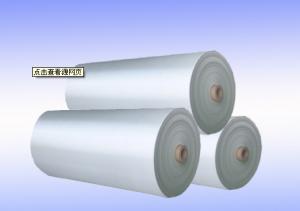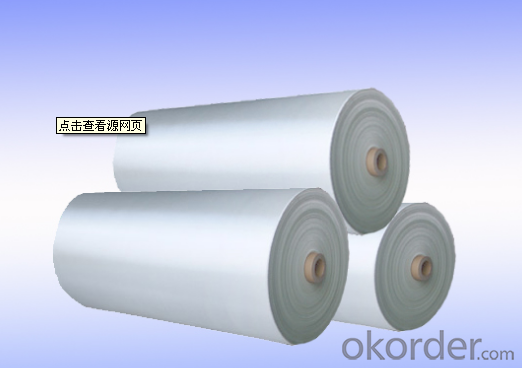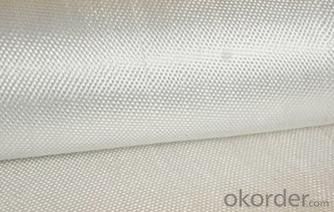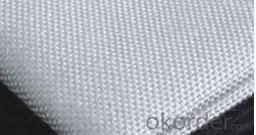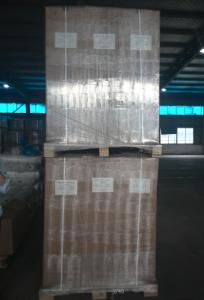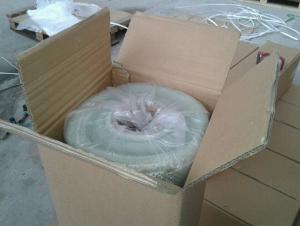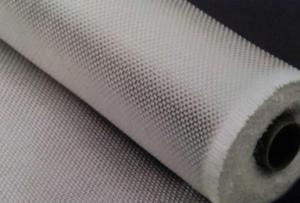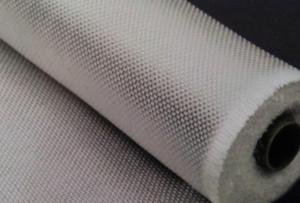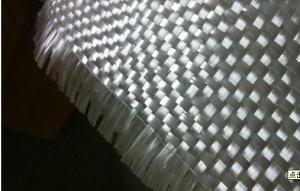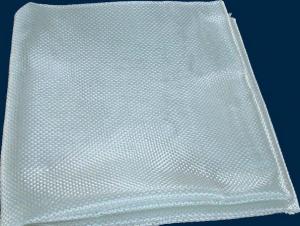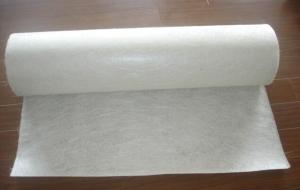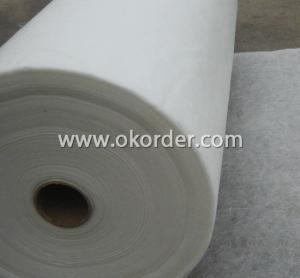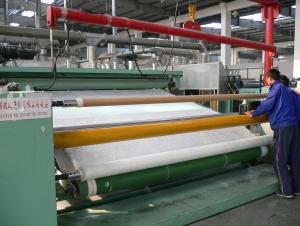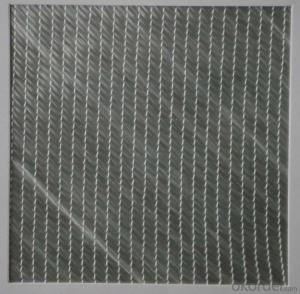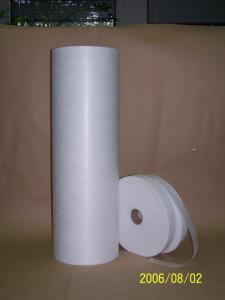Fiberglass Mat Tissue - E-Glass Fiberglass Woven Roving, 400g, 2000mm
- Loading Port:
- Shanghai
- Payment Terms:
- TT or LC
- Min Order Qty:
- 5000 kg
- Supply Capability:
- 300000 kg/month
OKorder Service Pledge
OKorder Financial Service
You Might Also Like
Structure of woven roving Description
1,high strenth,corosion and resistence
2,consistent thickness,no fuzz
3,rapid impregnating
Glass woven rovings are bidirectional fabric by direct rovings in plain weave pattern. They are applicable for hand lay-up, winding and compress molding process, suitable for manufacturing tank, boat, automobile parts and other FRP products.
Main Features of the woven roving
1)Drapes well to suit the surface of intricate moulds
2)Fast wet-through and wet out
3)Easy handing and better appearance of the composite parts
4)Compatible with Unsaturated polyester resin
5)Very high laminate strength properties
Woven roving Images

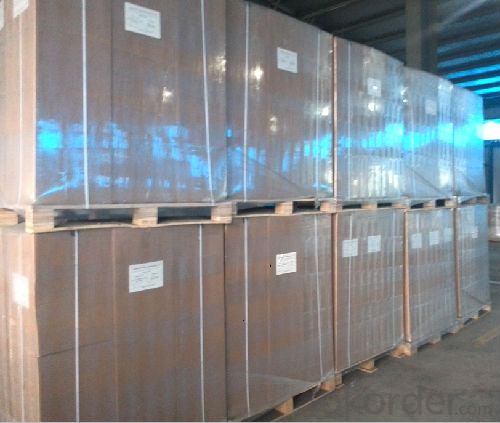
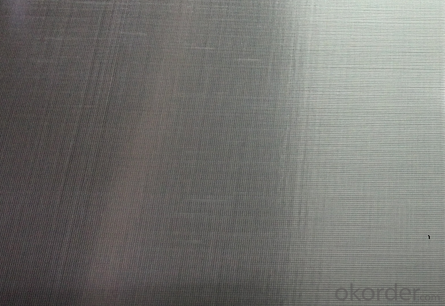
Woven roving Specification: weight& thickness
Normal type | EWR800-1000 | Test Standard |
Apperance | Good | GB/T 18370-2001 |
Density(warpxweft)(end/cm) | 1.8 X 1.5 | GB/T 7689.2-2001 |
Tex (warpxweft) | 2400x2400 | ISO1889 |
Moisture content(%) | ≤0.10 | ISO3344 |
Loss on ignition(%) | 0.40-0.80 | ISO1887 |
Glass | E-glass | N/A |
FAQ of woven roving:
Delivery Detail: 15-21days
Other spec. can be custom made as per customer's request.
- Q: Is fiberglass mat tissue suitable for wind energy applications?
- Yes, fiberglass mat tissue is suitable for wind energy applications. Fiberglass mat tissue is a lightweight and durable material that is commonly used in the construction of wind turbine blades. It provides excellent strength and stiffness, making it ideal for withstanding the high stresses and forces that wind turbines are subjected to. Additionally, fiberglass mat tissue is resistant to corrosion and degradation from UV radiation, ensuring the longevity and performance of wind turbine blades. Overall, the use of fiberglass mat tissue in wind energy applications allows for the production of efficient and reliable wind turbines that can generate clean and sustainable energy.
- Q: How does the roll length of fiberglass mat tissue affect its handling?
- The roll length of fiberglass mat tissue can have an impact on its handling. A longer roll length can make it more cumbersome and difficult to handle, especially if it is heavy. It may require more physical effort to transport and maneuver, which can slow down the installation process. On the other hand, a shorter roll length may be more manageable and easier to handle, allowing for quicker and more efficient use during installation. Ultimately, the roll length should be chosen based on the specific requirements of the project and the capabilities of the individuals handling it.
- Q: Does fiberglass mat tissue require any special precautions during storage?
- Yes, fiberglass mat tissue does require some special precautions during storage. Fiberglass is a delicate material and can be easily damaged if not stored properly. Here are some precautions to consider: 1. Keep it dry: Fiberglass mat tissue should be stored in a dry and moisture-free environment. Moisture can cause the material to lose its strength and integrity. 2. Avoid direct sunlight: UV rays from sunlight can degrade fiberglass over time. Store the material in a cool, shaded area away from direct sunlight to prevent any damage. 3. Protect from dust and dirt: Fiberglass mat tissue should be stored in a clean and dust-free environment. Dust and dirt particles can get embedded in the material, making it less effective. 4. Avoid extreme temperatures: Extreme heat or cold can also affect the quality of fiberglass mat tissue. It is best to store it in a temperature-controlled environment to prevent any damage. 5. Use proper packaging: If the fiberglass mat tissue comes with packaging, it is recommended to keep it in its original packaging to provide an additional layer of protection. If not, consider using a durable and moisture-resistant wrapping material. By following these precautions, you can ensure that your fiberglass mat tissue remains in good condition during storage and is ready for use when needed.
- Q: Can fiberglass mat tissue be used for insulation in chemical storage tanks?
- Indeed, insulation in chemical storage tanks can be achieved using fiberglass mat tissue. The exceptional insulation properties of fiberglass render it a fitting substance for tanks that house chemicals. Typically composed of finely interwoven glass fibers, the fiberglass mat tissue constitutes a robust and long-lasting material. Its application to the inner walls of the tank effectively insulates and thwarts heat transfer. Furthermore, fiberglass exhibits corrosion resistance and can endure the detrimental effects of the chemicals commonly stored within these tanks, making it an optimal option for insulation in chemical storage tanks.
- Q: What is the expected lifespan of fiberglass mat tissue in underground applications?
- Different factors can affect the expected lifespan of fiberglass mat tissue in underground applications. These factors include the conditions of the underground environment, the quality and thickness of the fiberglass mat tissue, and the level of maintenance and care provided. On average, fiberglass mat tissue is known for its durability and longevity, which makes it suitable for use underground. Generally, fiberglass mat tissue is designed to resist corrosion, moisture, and other environmental elements commonly found in underground settings. This makes it a reliable choice for protecting underground pipes, tanks, and other infrastructure from deterioration. When installed correctly and maintained regularly, fiberglass mat tissue can last 50 years or more in underground applications. However, it is important to note that this estimate can vary depending on the specific conditions and usage of the fiberglass mat tissue. To maximize the lifespan of fiberglass mat tissue in underground applications, it is recommended to follow industry best practices. These practices include using proper installation techniques, conducting regular inspections, and promptly addressing any cracks or damage. By following these steps, the lifespan of fiberglass mat tissue can be extended, ensuring long-term reliability and durability underground.
- Q: Can fiberglass mat tissue be used for insulation in commercial buildings?
- Fiberglass mat tissue can indeed be used for insulation in commercial buildings. Fiberglass is a commonly used insulation material due to its excellent thermal performance, durability, and cost-effectiveness. Fiberglass mat tissue is typically made from fine glass fibers that are bonded together using a resin. This mat can be applied to walls, ceilings, and other surfaces to improve the building's energy efficiency by minimizing heat transfer. In commercial buildings, proper insulation is crucial for maintaining a comfortable indoor environment and reducing energy consumption. Fiberglass mat tissue offers several advantages for insulation purposes. It has low thermal conductivity, meaning it can effectively resist heat flow and reduce heat loss or gain through the building envelope. This results in lower energy bills and improved temperature control. Additionally, fiberglass mat tissue is lightweight and easy to install, making it a convenient choice for commercial buildings. It can be easily cut and shaped to fit around obstacles, ensuring a tight seal and preventing air leakage. This helps to further enhance the insulation's effectiveness. Furthermore, fiberglass mat tissue is non-combustible, providing an added safety benefit in commercial buildings where fire protection is crucial. It does not contribute to the spread of flames, and its fire resistance properties can help contain fires and provide valuable escape time in case of emergencies. Overall, fiberglass mat tissue is a suitable and widely used insulation material for commercial buildings. Its thermal performance, ease of installation, and fire resistance make it a reliable choice for achieving energy efficiency and comfort in commercial spaces.
- Q: Does fiberglass mat tissue require any special surface treatments before application?
- Yes, fiberglass mat tissue typically requires a special surface treatment before application. This treatment usually involves priming the surface with a suitable resin or adhesive to ensure proper adhesion and bonding between the fiberglass mat tissue and the substrate.
- Q: How is fiberglass mat tissue used in the aerospace industry?
- Fiberglass mat tissue is extensively used in the aerospace industry due to its exceptional properties and versatility. It serves various purposes and plays a crucial role in the manufacturing and maintenance of aircraft. One of the primary applications of fiberglass mat tissue in the aerospace industry is its use in composite materials. Composite materials, which are made by combining two or more materials, are widely used in aircraft construction to reduce weight while maintaining structural integrity. Fiberglass mat tissue is often used as a reinforcement material in composite laminates. It provides strength, stiffness, and dimensional stability to the structure, making it suitable for various components such as wings, fuselage, and tail sections. The high tensile strength of fiberglass mat tissue ensures the composite structure can withstand the demanding conditions faced in the aerospace industry. Furthermore, fiberglass mat tissue is also utilized in the repair and maintenance of aircraft. It is commonly used in the process of composite patching, which involves repairing damaged or worn-out composite components. The fiberglass mat tissue is impregnated with resin and applied to the damaged area, providing strength and restoring structural integrity. This technique is widely employed for repairing aircraft components such as fairings, radomes, and other composite parts, ensuring their safe and reliable operation. Moreover, fiberglass mat tissue finds application in the insulation of aircraft. It is used as a thermal and acoustic insulation material in the interior cabin and other critical areas of the aircraft. Fiberglass mat tissue helps in reducing heat transfer, preventing condensation, and maintaining a comfortable cabin environment for passengers and crew. Additionally, its sound-absorbing properties help minimize noise levels inside the aircraft, enhancing the overall travel experience. In conclusion, fiberglass mat tissue is an indispensable material in the aerospace industry. It is used in the production of composite structures, repair and maintenance of aircraft, and as an insulation material. Its exceptional properties, including high tensile strength, dimensional stability, and thermal/acoustic insulation capabilities, make it an ideal choice for various applications in the aerospace industry.
- Q: Does fiberglass mat tissue require any special tools for installation?
- Yes, fiberglass mat tissue may require some special tools for installation. These tools can include a utility knife or scissors for cutting the mat to the desired size, a roller or brush for applying adhesive or resin to secure the mat to the desired surface, and safety equipment such as gloves and goggles to protect the installer from potential hazards. Additionally, some installations may require the use of a heat gun or torch to activate or cure the resin. It is important to read and follow the manufacturer's instructions and recommendations for the specific fiberglass mat tissue being used to ensure proper installation and to determine if any special tools are required.
- Q: What is the expected lifespan of fiberglass mat tissue in cleanroom applications?
- The expected lifespan of fiberglass mat tissue in cleanroom applications can vary depending on several factors. Generally, fiberglass mat tissue is known for its durability and long-lasting properties when used in cleanrooms. However, the lifespan can be influenced by variables such as the level of contamination, cleaning procedures, maintenance practices, and the overall conditions of the cleanroom environment. With proper care and regular maintenance, fiberglass mat tissue can typically last for several years in cleanroom applications. Frequent cleaning and replacing any damaged or contaminated sections can help extend its lifespan. It is also essential to follow the manufacturer's guidelines and recommendations for cleaning and maintenance to ensure optimal performance and longevity. Additionally, the quality and grade of the fiberglass mat tissue can also impact its expected lifespan. Higher-quality materials tend to be more resilient and can withstand environmental stressors better than lower-grade options. Therefore, investing in high-quality fiberglass mat tissue can contribute to a longer lifespan in cleanroom applications. In summary, while there is no definitive answer to the exact expected lifespan of fiberglass mat tissue in cleanroom applications, regular maintenance, proper care, and utilizing high-quality materials can significantly increase its longevity.
Send your message to us
Fiberglass Mat Tissue - E-Glass Fiberglass Woven Roving, 400g, 2000mm
- Loading Port:
- Shanghai
- Payment Terms:
- TT or LC
- Min Order Qty:
- 5000 kg
- Supply Capability:
- 300000 kg/month
OKorder Service Pledge
OKorder Financial Service
Similar products
Hot products
Hot Searches
Related keywords
